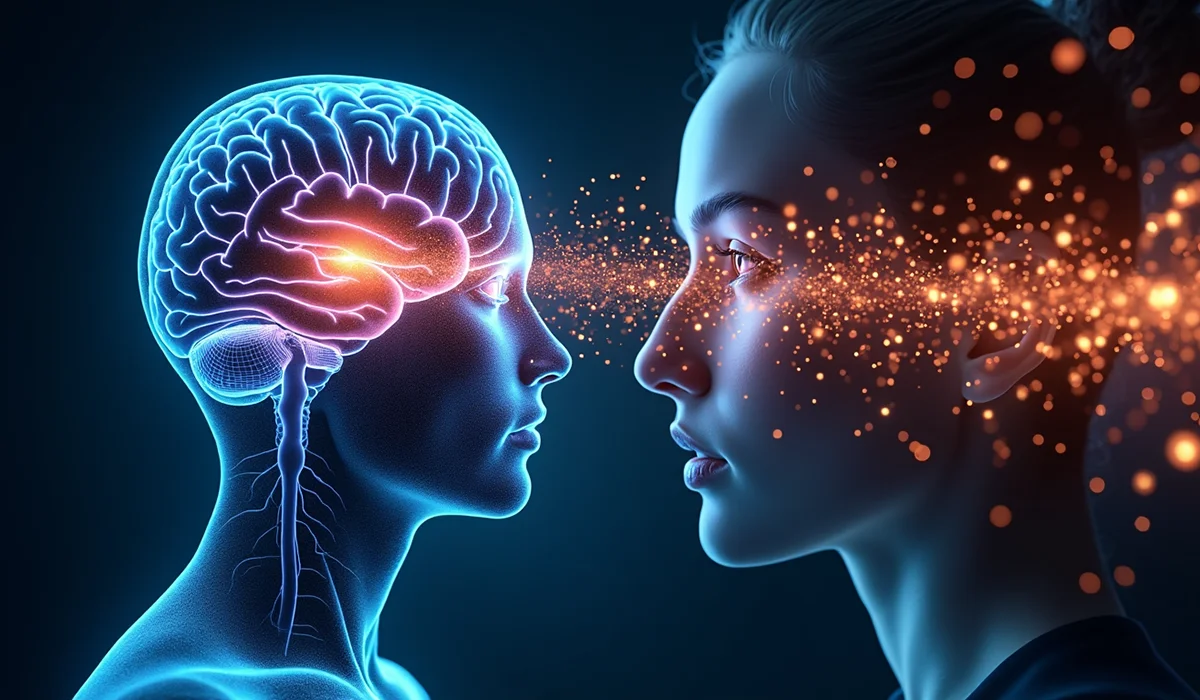Your brain makes purchase decisions several seconds before you become aware of them. Isn’t that remarkable? This fascinating insight is just one example of how the science of advertising and consumer neuroscience are revolutionizing our understanding of marketing effectiveness.
Neuromarketing, a field that blends neuroscience with marketing, reveals how our brains react to ads and marketing messages. In today’s world, thousands of advertisements bombard us each day, but only a select few manage to grab our attention and shape our purchasing behavior. This is where the power of emotional appeal in advertising comes into play.
The psychology behind marketing runs deeper than traditional market research can uncover. Modern neuromarketing research allows us to peer inside the human brain, unveiling why certain ads strike a chord while others miss the mark entirely. This article delves into our brain’s ad processing system and explores how different types of advertisements affect our minds. You’ll discover the elements that drive consumer choices and learn about advanced research methods that are transforming our grasp of buyer behavior and the intricate workings of advertising psychology.
Neural Mechanisms Behind Ad Processing
Brain science helps us learn about how people react to advertisements through neuromarketing research. The neural mechanisms in our brains shape how we respond to marketing messages, offering invaluable insights into the cognitive processing of ads.
The Role of the Prefrontal Cortex
The prefrontal cortex acts as our brain’s command center to process advertisements. Research shows the right prefrontal cortex relates to withdrawal behavior, while the left prefrontal cortex connects to approach behavior [1]. Scientists found that the inferior frontal gyrus links to pleasure responses, and the middle temporal gyrus ties to displeasure when people view ads [1].
Emotional vs Rational Brain Responses
In the realm of advertising psychology, emotional campaigns work significantly better than rational ones. Studies show that emotional-based advertising, or affective advertising, gets more attention and thus encourages better business results. These campaigns lead to higher long-term sales, market share, and customer loyalty [2]. Emotional commercials work better because:
- Our conscious minds are less likely to block them
- They build stronger brand connections over time
- They accelerate sales growth sustainably
- They create stronger memory associations
Emotions guide 80% to 95% of our purchase decisions [3]. People see 6,000-10,000 ads daily, yet most fail to stick in their minds [3]. This underscores the importance of emotional appeal in advertising and its impact on consumer behavior.
Memory Formation and Brand Recall
Memory formation is a vital part of how brands stick in our minds, playing a crucial role in brand recall and recognition. The hippocampus in the temporal lobe manages both input (encoding) and output (retrieval) of advertising information [1]. Studies reveal emotional ads achieve 81% brand recall compared to 69% for rational advertising [4]. Older adults respond even better to emotional advertisements, with 22% content retention versus just 7% for rational ads [4].
Neuromarketing techniques have shown that brain activation in specific regions can predict if an ad will work. Nielsen research found ads scoring above average on neuroscience-based tests boosted sales by 23% [4], highlighting the power of consumer neuroscience in predicting advertising effectiveness.
Brain’s Response to Different Ad Types
The human brain responds in unique ways to different types of advertising. Let’s look at what neuromarketing research tells us about these responses and how they inform the science of advertising.
Visual Advertisement Processing
Our brains activate multiple regions when we look at visual advertisements. Research shows visual ads trigger substantial activity in the orbitofrontal cortex and ventromedial prefrontal cortex. These areas are vital for perception and decision-making [5]. Small visual elements like facial expressions or the timing of brand placement can affect how our brains process and remember advertising information [6], influencing brand perception and recall.
Audio Advertisement Impact
Recent neuromarketing research reveals fascinating insights about audio advertising. Smart speaker audio ads that people can interact with boost brain activity by 25% compared to regular audio ads [7]. Here’s what we found about audio processing:
- Brain activity goes up by 30% the moment consumers say brand names during interactive audio ads [7]
- The brain responds 23% more strongly to audio ads versus just 4% for standard ads [7]
- Interactive audio leads to 8% better memory and 14% more engagement in the left brain [7]
These findings underscore the importance of auditory elements in creating effective advertisements.
Multi-sensory Marketing Effects
Advertising that combines different sensory elements creates powerful responses in the brain, exemplifying the science of advertising at work. The way consumers perceive brands changes through sensory marketing, which can affect their buying behavior without them realizing it [8]. Studies show that elements like music, lighting, and scent in stores affect the shopping experience substantially [8]. Brand associations become stronger and memories stick better when multiple senses are involved [6], highlighting the power of multi-sensory approaches in emotional branding.
Interestingly, audio content can sometimes create more emotional engagement than visual content. People who listen show higher heart rates, skin responses, and body temperatures compared to those who watch the same content [9]. This happens because audio requires more imagination, which creates deeper emotional connections with advertising messages, further emphasizing the importance of emotional appeal in advertising.
Neurological Factors in Consumer Decision-Making
Our neuromarketing research has uncovered interesting patterns about how the brain makes purchase decisions. Let’s examine the key neurological factors that shape consumer behavior and influence the effectiveness of emotional advertising.
Attention and Engagement Metrics
Research shows that consumers consider just 3-6 products in their final decision set, even with many more options available [10]. The brain’s attention processes work as first screening tools and help consumers narrow down choices before detailed analysis. Eye-tracking studies now measure exactly where consumers look and for how long [11]. This technology has found that 96% of viewers miss branding elements in the bottom-right corner of advertisements [12], providing valuable insights for optimizing visual identity in ads.
Emotional Arousal Patterns
Our study of consumer emotions shows that arousal levels significantly affect purchase decisions. Here are key findings from our physiological measurements:
- Heart rate variability is closely associated with consumer involvement [13]
- Pupil dilation shows emotional intensity during product evaluation [11]
- The nucleus accumbens’s brain activity increases before purchasing decisions [14]
These findings underscore the importance of emotional stimuli in advertising and their impact on consumer motivations.
Purchase Intent Indicators
The brain’s activity can predict purchase decisions before consumers become consciously aware of their choices [10]. This is our most compelling finding in the field of consumer neuroscience. The ventral tegmental area and nucleus accumbens become more active during positive purchase decisions [14]. Our research shows that compulsive buyers’ nucleus accumbens has higher activity and their insula has lower activation than non-compulsive buyers when they look at products and prices [14].
Advanced neuromarketing techniques now measure these complex processes with up-to-the-minute data analysis. Brain scanning studies show that high prices can trigger the insula’s activation, which indicates predicted loss [14]. Preferred brands activate the ventromedial prefrontal cortex, suggesting positive valuation [15]. These insights are crucial for understanding the effectiveness of emotional advertising and its impact on brand loyalty.
Advanced Neuromarketing Research Methods
Our neuromarketing research uses advanced technologies to understand how consumers respond to advertising. Let’s explore these advanced tools that help us delve deeper into the psychology of advertising and the science behind effective marketing strategies.
fMRI Studies and Insights
Functional Magnetic Resonance Imaging (fMRI) provides an excellent way to gain insights into consumer behavior. The technology measures blood flow changes in the brain and provides detailed 3D views of neural activity [1]. Research shows that fMRI effectively detects responses in deep brain structures, especially when measuring emotional responses to advertisements.
EEG Measurement Techniques
Electroencephalography (EEG) has become our most used method in neuromarketing practice and works best with ad testing [1]. EEG stands out because:
- It offers high temporal resolution in milliseconds
- It measures voltage changes through scalp sensors
- It detects oscillations between 7-12 Hz in the alpha frequency band
- It provides up-to-the-minute emotional response data
Studies show that EEG-based measures strongly correlate with market-level success [1]. The interpretation requires careful analysis of electrical signals’ spatial and temporal dimensions, providing valuable insights into cognitive processing of ads.
Eye-Tracking Technologies
Eye-tracking technology complements our neural measurements and provides explanations about visual attention patterns. This technology tracks fixation points, gaze duration, and pupil dilation [16]. Eye-tracking pinpoints exactly where consumers look and for how long, which helps analyze how well advertisements work. A newer study, published in 2023 by researchers, shows that combining eye-tracking with facial coding can link specific emotional responses to different stimulated elements in milliseconds [16], further enhancing our understanding of emotional advertising and its impact.
These advanced methods measure both conscious and unconscious responses to advertising stimuli. They help us learn about consumer behavior and decision-making processes in unprecedented ways, revolutionizing our approach to creating effective emotional commercials and brand messages.
Conclusion
Neuromarketing research has transformed our understanding of how ads influence human behavior and decision-making. Our extensive studies in consumer neuroscience show that emotional responses drive most purchase decisions. Brain activity predicts choices before we become consciously aware of them, highlighting the power of emotional appeal in advertising.
Our research in advertising psychology reveals these significant findings:
- Brain mechanisms process ads differently based on emotional and rational content
- Multi-sensory marketing creates stronger neural responses and brand associations
- Advanced technologies like fMRI, EEG, and eye-tracking help us learn about consumer behavior
- Neural activity in specific brain regions accurately predicts purchase decisions
- Emotional advertising campaigns work better for business results than rational ones by a significant margin
These insights help marketers create better campaigns that align with how the human brain naturally processes information. Emerging technologies continue to provide deeper insights into consumer behavior and decision-making processes.
A deeper understanding of neural responses is shaping the future of advertising. This knowledge helps us design messages that appeal more authentically to audiences while respecting the human mind’s natural workings. By leveraging the power of storytelling, emotional branding, and affective advertising, marketers can create more impactful and memorable campaigns that resonate with consumers on a deeper level.
As we continue to explore the intricate relationship between neuroscience and marketing, we’re uncovering new ways to enhance brand recall, foster brand loyalty, and create emotional resonance with audiences. The science of advertising is evolving, and with it, our ability to create more effective, engaging, and ethically sound marketing strategies.
References
[1] – https://pmc.ncbi.nlm.nih.gov/articles/PMC7378323/
[4] – https://www.neurosciencemarketing.com/blog/articles/emotional-ads-work-best.htm
[5] – https://pmc.ncbi.nlm.nih.gov/articles/PMC9774318/
[6] – https://www.campaignlive.com/article/creativity-tv-advertising-impacts-brain/1028747
[7] – https://uk.themedialeader.com/interactive-smart-speaker-ads-trigger-stronger-brain-activity/
[8] – https://pmc.ncbi.nlm.nih.gov/articles/PMC10376566/
[9] – https://www.neurosciencemarketing.com/blog/articles/audio-vs-video.htm
[10] – https://pmc.ncbi.nlm.nih.gov/articles/PMC4671287/
[11] – https://pmc.ncbi.nlm.nih.gov/articles/PMC10117197/
[12] – https://www.neuronsinc.com/insights/neuromarketing
[13] – https://advertisingweek.com/is-neuroscience-the-future-of-attention-metrics/
[14] – https://pmc.ncbi.nlm.nih.gov/articles/PMC3626833/



